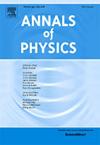修正重力下物质创造宇宙学的晚期宇宙加速
IF 3
3区 物理与天体物理
Q2 PHYSICS, MULTIDISCIPLINARY
引用次数: 0
摘要
在本文中,我们探索了由引力诱导的“绝热”物质创造所驱动的宇宙膨胀,这是一个在平坦的friedman - lema本文章由计算机程序翻译,如有差异,请以英文原文为准。
Late cosmic acceleration by matter creation cosmology in modified gravity
In this article, we explore the expansion of the Universe powered by the gravitationally induced ‘adiabatic’ matter creation, a non-equilibrium thermodynamical process in gravity in the background dynamics of a flat Friedmann–Lemaître–Robertson–Walker spacetime geometry. The action of gravity involves a general function of nonmetricity scalar . As the Universe expanding, the gravitational field of this expanding Universe is acting on the quantum vacuum, which results in a continuous creation of matter particles. Under the formalism of gravity, we obtain the analytical solutions of the cosmological quantities by assuming the ‘generalized Chaplygin gas’ (GCG)equation of state. A particular case of GCG equation of state is also studied. We analyze how matter creations play an effective role in the late-time evolution of the Universe in modified gravity. By using the latest observational datasets, including the type Ia supernovae (Pantheon), Cosmic Chronometer data, and Baryonic Acoustic Oscillations (BAO) we also perform a statistical analysis to test the observational viability of two models. The best-fit parameters are used to compare both models to CDM by means of the evolution of cosmological quantities, stability, and information selection criteria, namely, the Akaike information criterion and the Bayesian information criterion. We conclude that a flat Universe in our models with GCG is still supported by current observational data. Furthermore, the data shows a phantom nature of the equation of state for GCG model and de-Sitter model for Chaplygin gas in late-time evolution.
求助全文
通过发布文献求助,成功后即可免费获取论文全文。
去求助
来源期刊

Annals of Physics
物理-物理:综合
CiteScore
5.30
自引率
3.30%
发文量
211
审稿时长
47 days
期刊介绍:
Annals of Physics presents original work in all areas of basic theoretic physics research. Ideas are developed and fully explored, and thorough treatment is given to first principles and ultimate applications. Annals of Physics emphasizes clarity and intelligibility in the articles it publishes, thus making them as accessible as possible. Readers familiar with recent developments in the field are provided with sufficient detail and background to follow the arguments and understand their significance.
The Editors of the journal cover all fields of theoretical physics. Articles published in the journal are typically longer than 20 pages.
 求助内容:
求助内容: 应助结果提醒方式:
应助结果提醒方式:


